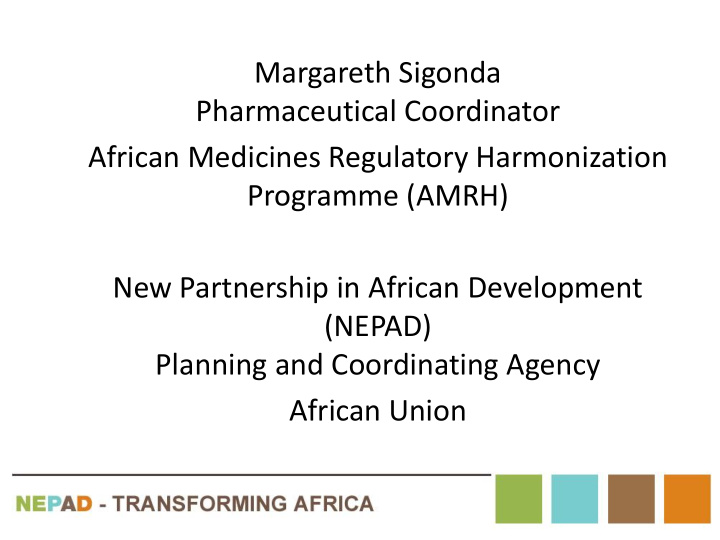



Margareth Sigonda Pharmaceutical Coordinator African Medicines Regulatory Harmonization Programme (AMRH) New Partnership in African Development (NEPAD) Planning and Coordinating Agency African Union
CPTR Workshop, Washington DC, 24-25 September, 2014 African Medicines Regulatory Harmonization Initiative …Collaboration Among Countries NEPAD Planning and Coordinating Agency
Presentation Outline • The AMRH Background & Vision • AMRH Progress • AMRH Collaborative Procedures • Conclusion
Background 2005-2007: AU Pharmaceutical Manufacturing Plan for Africa (PMPA) Increased access to Pharmaceuti medical cal sector products Creating development and an (Optimizing the technologi African Market Enabling AU-Roadmap for new es Regulatory on Shared medical Environme Responsibility products and nt technologies) & Global AU- Solidarity for PMPA ATM response in Africa
The AMRH Background & Vision… Effective and Efficient regulation of medical products: • Investment incentive for industry • Key for attainment of Universal Health Coverage • Hampered by prevailing capacity limitations in Africa, World Health Organization (WHO) Study Report 2004: – 4% of countries with moderate capacity – 33% some capacity to carry out most functions – 24% basic capacity to carry out minimum functions – 39% of countries with limited capacity
The African Medicines Regulatory Harmonization Initiative The African Medicine Regulatory • Initial stakeholder Harmonization (AMRH) initiative aims to 2009 engagement (NEPAD) accelerate the access to products by improving the fragmented system of product • Regional proposals registration in Africa 2010/ 2011 developed • Multi-donor trust- Main focus • Develop common requirements / fund established 2011 guidelines / format • EAC harmonization • Work sharing among countries 2012 launched • Streamlined regional decision making at the regional level • Focus on 2013/ Current Partners WAHO/UEMOA and 2014 SADC Region projects RECs, NEPAD, WHO, World Bank, BMGF, DfID consolidation
Vision for AMRH Programme IGAD / AMU / CEN-SAD African Medicines WAHO / Agency EAC UEMOA Vision: East African ECCAS/ Community Medicines OCEAC and Food Safety SADC/CO Commission MESA MRH Project launched March 2012 55 countries 5regions 1 continent
Roughly 85% of Sub-Saharan Africa covered with medicines registration harmonization (MRH) Projects at different levels REC progress CEN-SAD/UMA/COMESA • Status • Comments • REC • EAC • Implementation • Launched 2012 IGAD • OCEAC/ECCAS • In progress • WAHO/UEMOA • In progress • Launch of Steering • SADC • In progress Committees Expected 2014 • North/Northeast • Ongoing discussions EAC Africa ECCAS/OCEAC % pop Countries Total Completed or in-process RECs covered members* covered EAC & OCEAC 12 (20%) 11 17% EAC, OCEAC, ECOWAS 26 (46%) 26 45% EAC, OCEAC, ECOWAS, SADC 41 (74%) 41 72% SADC We are pushing forward those RECs that are ready while continuing to work with the remaining regions 9/30/2014 8 8
EAC Plan for Joint Assessment • Borrow the idea from WHO PQ • Lead country, TFDA prepares a call for Expression of Interest – with agreed list of products – Simultaneous submission to EAC Partner States’ NMRAs – Secretariat coordinates joint assessment sessions – Country approvals of jointly accepted product s NOTE……… – EAC Harmonized guidelines for registration of medicines and GMP inspection have been approved by the Council of Ministers – 20 September 2014 – Effective date for implementation - 1 st January 2015 9
In Conclusion • AMRH provides a platform for collaboration among African countries in the implementation of harmonised regulatory requirements and standards • Work sharing among countries, trust building and streamlined regional decision making at the regional level among participating member states belonging to a regional economic community is key for success • CPTR can borrow leaf from the working models and employ the same methodology for TB drugs
Thank You
Recommend
More recommend